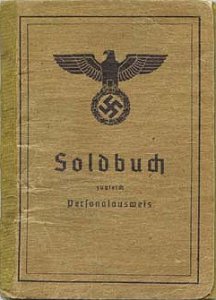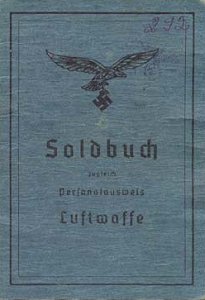
By Sebastián Bianchi
Soldbuch
When an individual presented himself for active duty, he turned in his Wehrpass and received an Erkennungsmarke and a Soldbuch, which was the basic identity document that the soldier would carry on his person for the rest of his active military career. The title “pay book” is somewhat misleading, because little or no pay is actually recorded in the document. Instead, the book gave the soldier the authority to draw pay, and in fact the original intent of the document was to allow individuals to draw pay from a unit other than their own.
In practice, the Soldbuch was the identity document that most concerned
active duty personnel. Inside its tan leather cover, the 24 pages contained an
array of information that included the soldiers’ current and past assigned units
(former units were crossed out but legible), pay rate, awards, equipment/weapons
issued, clothing, Erkennungsmarke number, and some medical history. Inside
the flap 5 rules of the Soldbuch were presented for study, they were,
1) The Soldbuch provides the soldier with personal identification in wartime and gives him the authority to receive pay from his own or other duty stations. It may also be used as an identification for purposes of receiving mail, traveling on trains, detached service and while on leave.
2) The Soldbuch must always be carried by the soldier in the tunic pocket. Leaving it in baggage, in quarters, etc., is not allowed. Talking good care of the Soldbuch is in the best interest of the owner.
3) The Soldbuch has to be kept in an orderly manner. The owner himself is required to make certain that changes in pay rate due to transfer of promotion are promptly entered at his duty station.
4) The Soldbuch is an official document. Entries in it can be made only by a duty station of the Armed Forces. Unauthorized changes to the Soldbuch are falsification of official documents (a crime).
5) The loss of the Soldbuch must be reported at once by the owner to his unit
or duty station, where steps will be taken to issue a new Soldbuch.
When stopped or questioned by the Wehrmacht Military Police or a superior
officer, this was the document that the soldier would be required to show. It
would not escape the inquirer's eye if the equipment and decorations that the
soldier had did not match those inscribed in his Soldbuch.
All branches of the Wehrmacht issued Soldbuchs with slight variations on the
cover and in content. Cover variation are as follows;
The Luftwaffe Soldbuch had the Luftwaffe eagle on the cover, the Kriegsmarine
was identical to the Heer except that the word “Kriegsmarine” was printed on the
cover. SS Soldbuchs had the SS symbol printed in the front.
|
|
|
The Police Forces of the Reich were also issued Soldbuchs, as were the forces of the Volksturm. In essence, Volksturm Soldbuchs were watered-down versions of the Heer Soldbuchs, containing only 14 pages of information.
Upon the release of a soldier from the Wehrmacht, the Soldbuch was supposed to
the destroyed, and many German service men did indeed destroyed them at the end
of the war. However, due to the sudden collapse of Germany, other men kept their
Soldbuchs as their only identity document, and another contingency was captured
with this document in their possession. As a result, as with the
Wehrpass, there are many Soldbuchs available to collectors and historians, with
the price varying depending on entries and units served with.
![]()
© Copyright Wehrmacht-Awards.com LLC |

